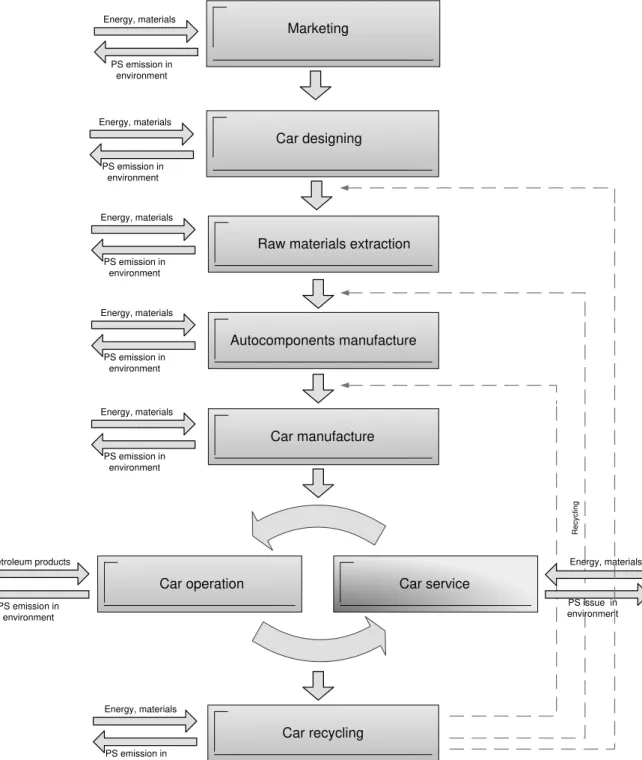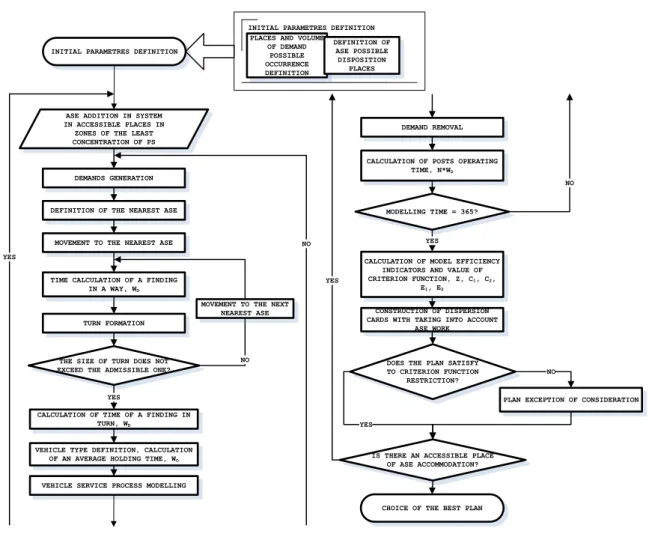PROBLEMY TRANSPORTU Volume 6 Issue 3 autoservice, environment
Vadim MAVRIN*, Irina MAKAROVA, Rifat KHABIBULLIN, Polina BUYVOL
Kama State Academy of Engineering and Economic
Mira prosp., 68/19, 423810, Naberezhnye Chelny, Russian Federation
*Corresponding author. E-mail: vadim_mmite@rambler.ru
MOTOR TRANSPORT INFLUENCE DECREASE ON ENVIRONMENT BY
PERFECTING AUTOSERVICE SYSTEM
Summary. In the article for motor transport influence decrease on the environment it is offered to perfect an autoservice system in two directions: to optimize autoservice enterprises territorial accommodation and to increase an internal efficiency of organization and operation of enterprises. The first way means rational territorial accommodation of autoservice center with taking into account of ecological factors for an even distribution of autoservice centers load on environment. The second way demands creation and intrusion on autoservice centers of an ecological management system with for a decrease by centers of pollutants emissions volumes in environment.
Ы
А тация.:
.
.
,
.
1. INTRODUCTION
Today one of the acute problems of the Russian Federation is worsening ecological conditions. So, being on the eleventh place in the world on gross national product volume, Russia is the largest emitter of polluting substances (PS), conceding on this indicator only the USA and China. Thus the contribution of an automobile complex, including extraction and processing of raw materials for vehicles, their assemblage, operation, service and recycling, makes by different estimations of experts up to 70 % of emissions of polluting substances of the country.
2. PROBLEM STATEMENT
under the pressure of public opinion and proceeding from economic reasons, world car manufacturers give a close attention to decrease PS issue at all stages of vehicle life cycle. The majority of large companies have effective ecological management system (EMS), seriously concern selection of suppliers, demanding from them functioning EMS, improve fuel-ecological and economic characteristics of the cars. Thus the contribution of vehicles technically serviceable condition maintenance process as parts of the vehicle life cycle in environmental contamination is considered to a lesser degree. Therefore in this part there are big reserves for decreasing in negative influence of the car on environment.
Meanwhile, the technological base of the car-care enterprises, intended for storage of cars, their maintenance operations and repair, is one of those structures of a motor transportation complex, which represent the greatest threats for ecological safety. The contribution of stationary sources on balance of the car-care enterprises, makes 6-18 % of general PS emissions in large cities atmosphere[1].
Decrease in negative influence of the autoservice enterprises (ASE) on environment is possible in the presence of creation of really functioning system of the ecological management answering to ISO 14001 standard at the enterprises. Process of EMS creation and certifications to ISO 14001 is expensive. However assisting the dealers in the course of EMS creation is in the interests of car manufacturers. They can act as initiators, investors and advisers at the certification of the ASE. In this case manufacturers can declare, that their production is really ecologically safe at all stages of life cycle.
Another way of problem decision - use of scientifically-proved methods and models at designing of a dealer-service network with a view of uniform distribution of ASE influence on the SE by the optimisation of the territorial placing of the ASE taking into account ecological factors.
The dealer-service network represents difficult organizational-technical system at which designing using of imitative modelling methods gives the best result, because in this case entrance streams are not limited to requirements of stationarity, uniformity, consequence absence etc., that allows to receive the result confirmed with practical experience in the course of modelling [2].
As an object of modelling the territory is represented (for example, a city) where it is possible to allocate places of cars concentration and places of car-care enterprises disposition. Modelling process is offered to begin with the task of initial parametes (definition of places of a motor pool concentration, forecasting of demand, definition of the admissible places of enterprises disposition), and also an initial condition of ASE network.
The overwhelming quantity of vehicles in large cities is stored on open supervised parkings, in garage co-operative societies and near-house territories (court yard). Therefore model working out we will consider under a place of cars disposition and, accordingly, a place of demand occurrence ( cars requiring maintenance operations and repairs) parking, garages and groups of houses. The quantity of cars stored on parking and in garages can be defined empirically, the rest of parking is counted from capacity near-house territories.
In the definition of the admissible places of the enterprises disposition it is necessary to consider legislative interdictions for ASE placing in certain places and an ecological interdiction for ASE placing in those zones where concentration of polluting substances exceeds maximum-permissible norms as additional sources of pollution in these zones will affect extremely negatively on SE condition. Thereupon, the sizes (quantity of posts) autoservice enterprises should be minimize to influence on environment in the least way, and they should settle down as closer to sources of demand occurrence (to apartment houses, parking and garages) as it is possible for minimisation influence on SE and clients` expenses on vehicle delivery, but their arrangement should not contradict the current legislation and standard documents. Besides, the ASE sizes should be sufficient to minimise owners` expenses for expectation in turn.
it is necessary, that a quality and a spectrum of services and price policy of ASEs do not differ, and clients prefer to serve cars in the nearest ASE. Indicators of model efficiency (owners` expenses for vehicle delivery and expectation in turns, number to satisfied demands, an idle time of posts) are found for each iteration. The best variant (number of the plan and iteration number) is to get by results of the indicators analysis. The block diagram of algorithm of choice ASE placing at network designing model functioning is presented on Fig. 2.
Autocomponents manufacture Raw materials extraction
Car manufacture
Car service
Car recycling Energy, materials
PS emission in environment
Energy, materials
PS emission in environment
Energy, materials
PS emission in environment
R
e
cycl
in
g
Energy, materials
PS emission in environment petroleum products
PS emission in environment
Energy, materials
PS issue in environment Car designing
Energy, materials
PS emission in environment
Marketing
Car operation Energy, materials
PS emission in environment
Fig. 1. The block diagram of vehicle life cycle
-INITIAL PARAMETRES DEFINITION
INITIAL PARAMETRES DEFINITION PLACES AND VOLUME
OF DEMAND POSSIBLE OCCURRENCE DEFINITION DEFINITION OF ASE POSSIBLE DISPOSITION PLACES DEMANDS GENERATION
DEFINITION OF THE NEAREST ASE
MOVEMENT TO THE NEAREST ASE
TURN FORMATION
VEHICLE TYPE DEFINITION, CALCULATION OF AN AVERAGE HOLDING TIME, WO
VEHICLE SERVICE PROCESS MODELLING THE SIZE OF TURN DOES NOT EXCEED THE ADMISSIBLE ONE?
YES
NO MOVEMENT TO THE NEXT
NEAREST ASE YES
NO YES
MODELLING TIME = 365?
IS THERE AN ACCESSIBLE PLACE OF ASE ACCOMMODATION? YES
DEMAND REMOVAL
CHOICE OF THE BEST PLAN
NO
YES
CONSTRUCTION OF DISPERSION CARDS WITH TAKING INTO ACCOUNT
ASE WORK
DOES THE PLAN SATISFY TO CRITERION FUNCTION
RESTRICTION?
PLAN EXCEPTION OF CONSIDERATION NO
ASE ADDITION IN SYSTEM IN ACCESSIBLE PLACES IN ZONES OF THE LEAST CONCENTRATION OF PS
TIME CALCULATION OF A FINDING IN A WAY, WD
CALCULATION OF TIME OF A FINDING IN TURN, WD
CALCULATION OF POSTS OPERATING TIME, N*WD
CALCULATION OF MODEL EFFICIENCY INDICATORS AND VALUE OF CRITERION FUNCTION, Z, C1, C2,
E1, E2
Fig. 2. Algorithm of the car-care enterprises placing model . 2.
It is possible to present a mathematical formulation of imitating model as follows:
, min 1 2 1 k k E Z Z Z
(1)
where:
1 21W ,W ,W C C
Z p d w – expenses of car-care centre system, rbl.,
1 22 W ,n E E
Z d – size of the damage rendered to environment, rbl., p
W S
C1 1 ,
S
1 – expenses of the enterprises connected with idle time of one post per day, rbl./day, pW – total idle time of posts of the car-care enterprises , days,
Wd Ww
S
C2 2 – owners` expenses for vehicle delivery for maintenance operations and repairs and expectation in turn,
2
S
– average wages, rbl./day, dW
andW
w – total time of all automobile delivery for maintenance operations and repairs and a total waiting time of service of all references accordingly, days,n
E
1
– size of an ecological damage from activity of the autoservice enterprises, rbl., – size of an ecological damage on one car-arrival, rbl.,m d
W
E2
– the size of an ecological damage connected with cars delivery on ASE, rbl.,
– average speed of movement of cars of considered system, km/h, m – size of an ecological damage from car movement on 1 km,
kk
E1
– the restriction imposed on territorial placing of the car-care enterprises (concentration PS should be less than maximum permissible).3. CONCLUSION
As a result of model realisation it is possible to find balance between indicators of a system effectiveness of car-care centre (expenses of the car-care enterprises connected with idle time of posts), satisfactions of ASE clients (owners` expenses for vehicle delivery for maintenance operations
and repairs, a waiting time in turn) and influences on environment (volume of an ecological damage).
References
1. . .: и и ия ия ия и и
и : У и . - , , 2005.
2. . .: и и и и ия и и и :
У и . , , 2003.

